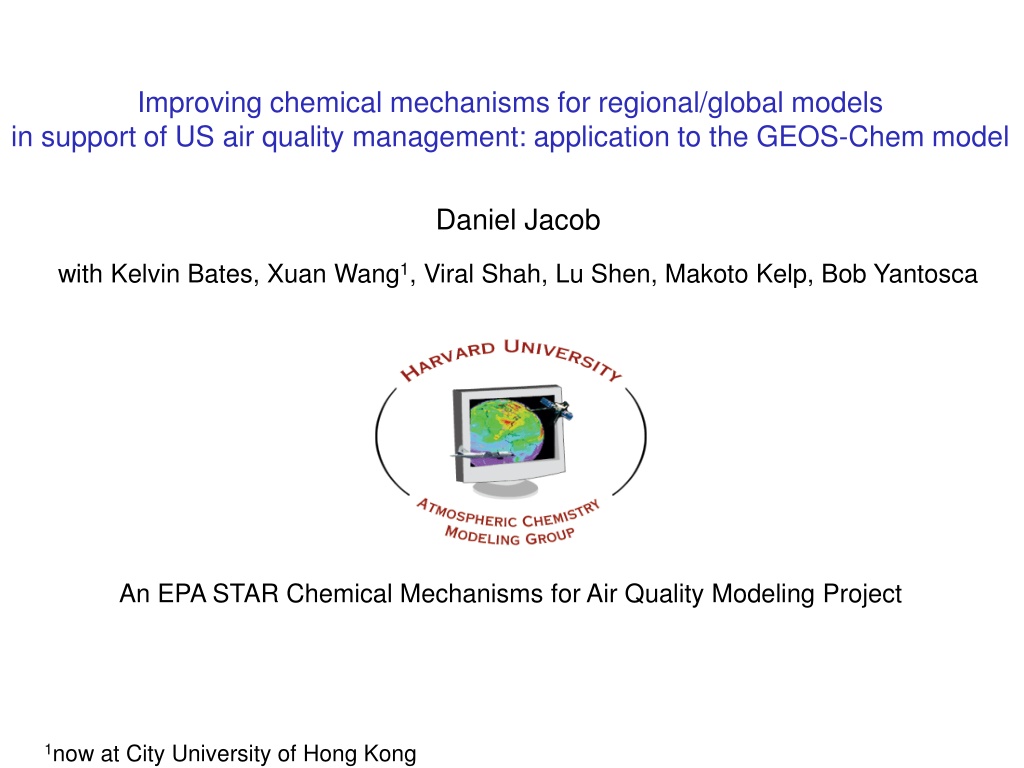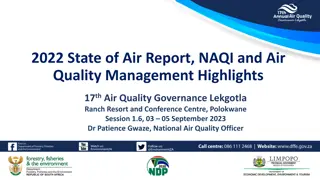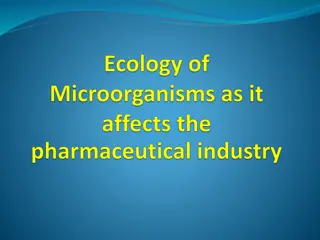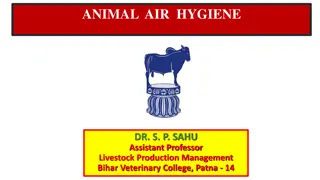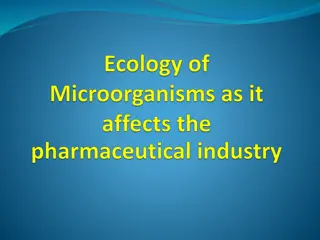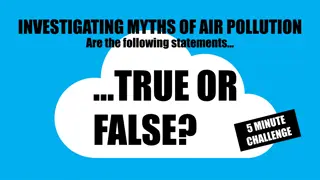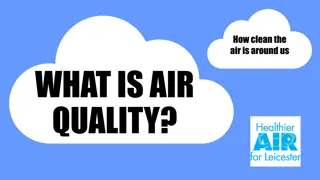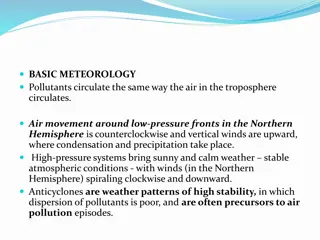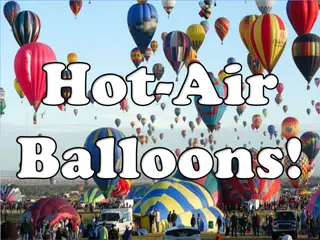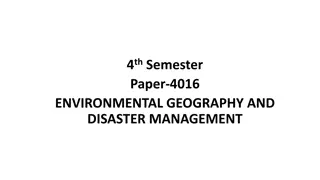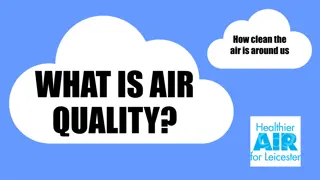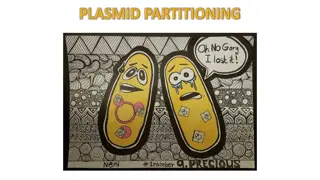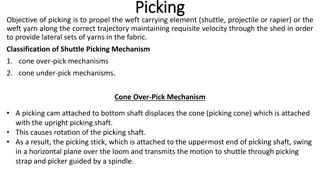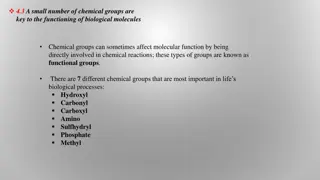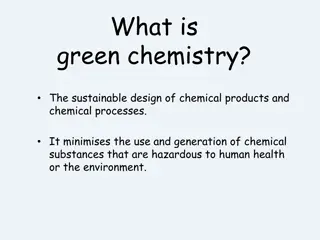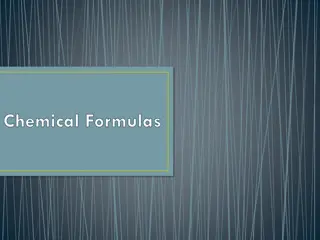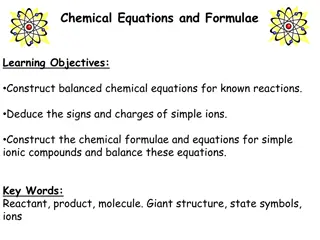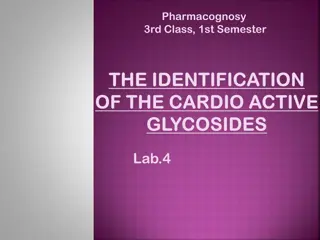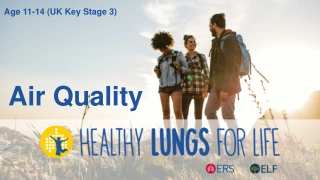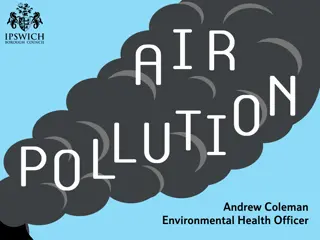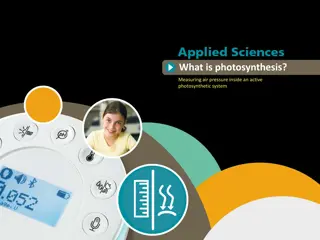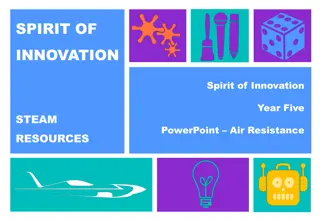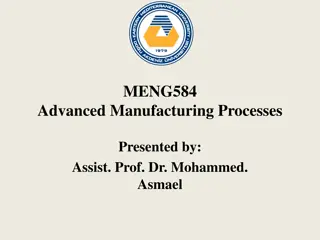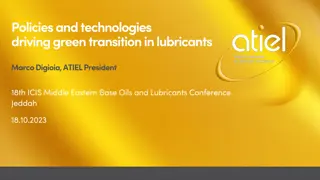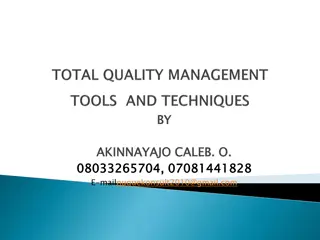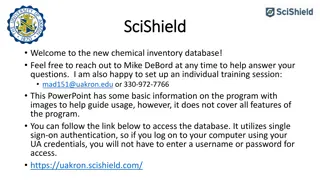Advancements in Chemical Mechanisms for Air Quality Management
Daniel Jacob and team have been enhancing chemical mechanisms in the GEOS-Chem model to support US air quality management. Ongoing work includes developing new mechanisms for aromatic VOCs, tropospheric halogens, mercury redox, adaptive mechanism reduction, machine learning applications, and unification of GEOS-Chem mechanisms under KPP. Their efforts aim to improve simulations of ozone, PAN, and SOA, utilizing satellite data and focusing on specific chemical cycles. Mechanisms intercomparison studies reveal insights into the production of glyoxal and methylglyoxal, the impact of HOx sources, and the role of aromatic VOCs on OH concentrations. These advancements contribute to a better understanding of atmospheric chemistry and pollution dynamics.
Download Presentation

Please find below an Image/Link to download the presentation.
The content on the website is provided AS IS for your information and personal use only. It may not be sold, licensed, or shared on other websites without obtaining consent from the author. Download presentation by click this link. If you encounter any issues during the download, it is possible that the publisher has removed the file from their server.
E N D
Presentation Transcript
Improving chemical mechanisms for regional/global models in support of US air quality management: application to the GEOS-Chem model Daniel Jacob with Kelvin Bates, Xuan Wang1, Viral Shah, Lu Shen, Makoto Kelp, Bob Yantosca An EPA STAR Chemical Mechanisms for Air Quality Modeling Project 1now at City University of Hong Kong
GEOS-Chem as a modular platform for mechanism development GEOS-Chem chemical module: chemistry (FlexChem-KPP) emissions deposition dC/dt = P L + E - D transport C(x, t + t) C(x, t) (x, y) on-line in meteorological model (solves for chemical transport) off-line (archived winds) NASA GEOS [Hu et al., GMD 2018], GEOS forecasts [Keller et al., JAMES 2020] WRF [Lin et al., GMD 2019] BCC-ESM [Lu et al., GMD 2020] NCAR CESM (in progress) GC-Classic [Bey et al.,JGR 2001] GCHP [Eastham et al., GMD 2018] Stretched-grid GCHP [Bindle et al., GMD 2020]
Ongoing work 1. New reduced mechanism for aromatic VOC chemistry (Kelvin Bates) 2. New mechanism for tropospheric halogen (Cl-Br-I) chemistry (Xuan Wang) 3. New mechanism for mercury redox chemistry (Viral Shah) 4. Adaptive reduction of chemical mechanisms for global models (Lu Shen) 5. Application of machine learning to chemical solvers (Makoto Kelp) 6. Unification of GEOS-Chem chemical mechanisms under KPP (Bob Yantosca)
New reduced mechanism for aromatic VOCs Mechanism MCM v3.1 MECCA SAPRC-11 CRI v2-R5 RACM2 MOZART-T1 This work Species Reactions 1271 3788 229 666 55 374 56 128 34 115 13 43 18 46 Motivation: Simulation of ozone, PAN, SOA Use of glyoxal/formaldehyde satellite data First stage: phenoxy-phenylperoxy cycle: catalytic ozone loss Second stage: Benzaldehyde Bates et al., in prep.
Mechanisms intercomparison in box model This work This work Large production of glyoxal and methylglyoxal following ring-breaking Source of HOx from photolysis of dicarbonyls Ozone sink at low NOx from phenoxy-phenylperoxy cycling Bates et al., in prep.
Seasonally varying effects on OH concentrations GEOS-Chem simulation with vs. without aromatic VOCs: change in boundary layer OH Large HOx source in winter from photolysis of HCHO and dicarbonyls drives winter-spring spread of ozone pollution in northern China Bates et al., in prep.
New mechanism for tropospheric Cl-Br-I chemistry GEOS-Chem global masses in Gg [ppt in brackets], rates in Gg a-1 Cl radical production from SSA acid displacement and heterogeneous chemistry ClNO2 chemistry as ozone source in high-NOx regions BrOx radical production from HOBr + Cl- Cl atom accounts for only 1% of global methane loss Wang et al., in prep
New mechanism for tropospheric Cl-Br-I chemistry GEOS-Chem global masses in Gg [ppt in brackets], rates in Gg a-1 Global daytime BrO 0.5 ppt, drives ozone loss Br atoms provide dominant oxidant for Hg(0) Wang et al., in prep
New mechanism for tropospheric Cl-Br-I chemistry GEOS-Chem global masses in Gg [ppt in brackets], rates in Gg a-1 Catalytic ozone loss and OH production through HOI Wang et al., in prep
Global annual halogen-driven changes in oxidants surface tropopause OH and NOx increases over land mostly from ClNO2 chemistry Ozone loss mostly from BrOx chemistry Wang et al., in prep
New mechanism for Hg(0)/Hg(II) redox chemistry First-generation Hg(II) products have very short lifetimes against photolysis Push Hg(II) to stable forms: HgBrOH, Hg-Org, HgCl2 Shah et al., in progress
Observational constraints on Hg(0)/Hg(II) redox chemistry Global Hg(0) distribution: lifetime 6-9 months against deposition (here 9 months) Hg (II) wet deposition fluxes Hg(0) seasonal variation at northern and southern mid-latitudes Fast depletion of Hg(0) above tropopause Shah et al., in progress
Evaluation with MDN observations over North America We do not capture Southeast US maximum associated with deep convection https://www.eol.ucar.edu/dir_off/ASR/FY2000/images/hector1.jpg Global Hg(II) pool scavenging Need to increase Hg(II) pool in free troposphere Shah et al., in progress
Adaptive reduction of chemical mechanisms in global models GEOS-Chem mechanism (262 species, 850 reactions) covers all bases in troposphere and stratosphere but is often a severe overkill: reactive VOCs may be unimportant outside source regions day and night, troposphere and stratosphere involve different species a July day at 0 GMT % of fast species in mechanism with P or L larger than threshold = 102 cm-3 s-1 Can we reduce the mechanism locally to include only fast species in the coupled chemical solver? Problem is computational overhead in diagnosing/constructing local mechanism and Jacobian matrix Solution: have library of pre-constructed sub-mechanisms from which model picks locally and on the fly Santillana et al., AE 2010; Shen et al., GMD 2019
Selection of 20 sub-mechanisms to cover all atmospheric regimes Apply machine learning algorithm to GEOS-Chem gridboxes globally, diagnosing species with max(P,L) < and accounting for chemical connections 13 species groups (blocks) 20 submechanisms Submechanisms and percentage of gr idboxes using each mechanism (A) Composition of the 20 submechanisms (B) Percentage of gridboxes using each submechanism 1 13% 2 16% 3 18% 4 20% 5 25% Percentage of full mechanism 6 25% 7 30% 8 32% Submechanisms 9 32% 10 39% 11 39% Avoid NMVOC chemistry in half of gridboxes 12 39% 13 46% 14 53% 15 60% 16 67% 17 73% 18 76% 19 83% 20 90% 21 100% 1 2 3 4 5 6 7 8 9 10 11 12 13 0 5 10 15 20 halogens Blocks Percentage (%) anthro VOCs oxidants aerosols bio VOCS inorganic halogens organic and SOA Shen et al., submitted
Adaptive mechanism reduction in GEOS-Chem: 70% decrease in # coupled species, 50% gain in CPU time, <1% error Median RRMS error over 3 year simulations % error over 3-year simulation (a) d=500 (b) d=1000 (c) d=1500 Median RRMS error (%) Median RRMS error (%) Median RRMS error (%) M= 20, N= 13 = 500 cm-3 s-1 ozone OH NO2 sulfate All species 2.0 2.0 2.0 1.0 1.0 1.0 0.0 0.0 0.0 0 5 10 simulation month 15 20 25 30 35 0 5 10 15 20 25 30 35 0 5 10 15 20 25 30 35 Simulation time (months) Advantages: Simplify only where warranted Keep full diagnostic info Allow mechanism updates Shen et al., submitted
Application of machine learning to chemical solvers Why: chemical calculation is expensive, highly repetitive, fully deterministic Why not: high dimensionality, error growth Recursive neural network algorithm with encoder/decoder: Reduces dimension along dominant manifolds Recursive fit allows capture of longer modes to reduce error growth Kelp et al. [JGR 2020]
Application of NN solver to SuperFast mechanism in GEOS-Chem Global chemical mechanism with only 15 species [Brown-Steiner et al., GMD 2018] Error in simulating surface ozone in 30-day simulation Random-forest algorithm [Keller and Evans, GMD 2019] On-line trained NN algorithm (this work) Beijing ocean Need to check other species, error growth Why is on-line training so important? Kelp et al., in progress
Plans for coming year 1. Unify all GEOS-Chem chemical mechanisms under KPP 2. Complete/submit aromatic VOC mechanism paper, develop SOA mechanism 3. Complete/submit halogen mechanism paper 4. Complete/submit mercury mechanism paper 5. Intercompare isoprene mechanisms, develop SOA mechanism 6. Implement adaptive mechanism reduction in standard GEOS-Chem 7. Complete/submit implementation of ML solver in SuperFast mechanism, apply to full GEOS-Chem mechanism
